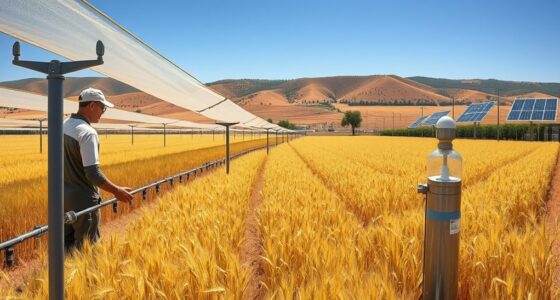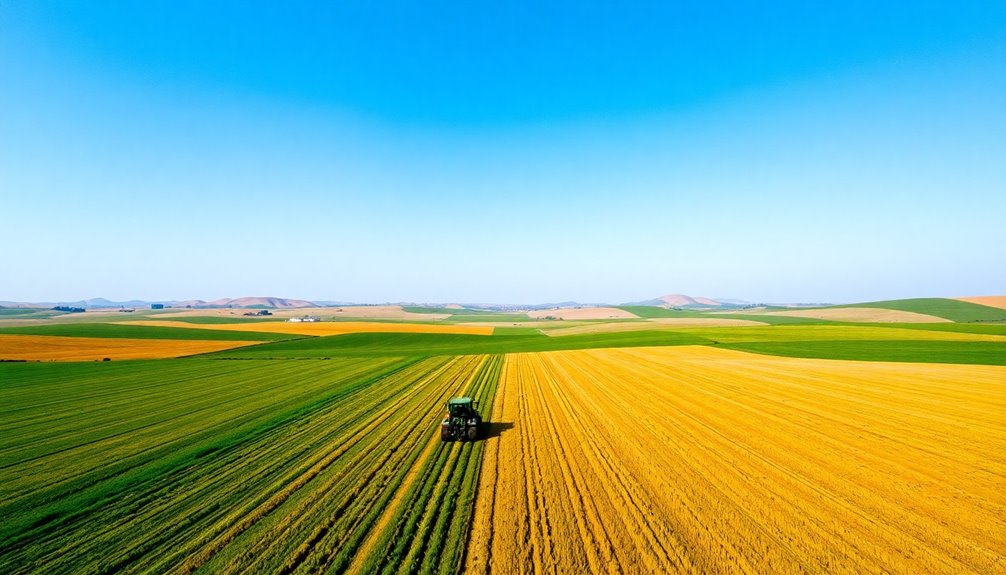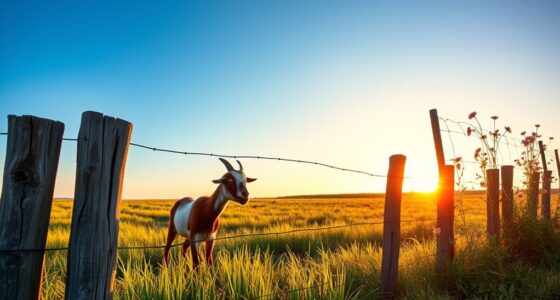To build a secure fence for your farm animals, choose durable materials like high-tensile wire or electric fencing, guaranteeing proper installation and grounding. Regularly tension the wires and inspect for weaknesses, repairing any damage promptly. Keep vegetation trimmed and ensure the fence is tall enough to prevent animals from jumping over. Adding buried wire mesh or wildlife barriers can stop burrowing intruders. Keep these tips in mind to effectively safeguard your animals—as you’ll discover, maintaining your fence is key to long-term security.
Key Takeaways
- Select durable fencing materials like high-tensile wire or woven wire to ensure strength and animal containment.
- Properly install and anchor fences to prevent gaps and weaknesses that wildlife can exploit.
- Maintain appropriate fence height and tension, regularly inspecting and repairing for sustained security.
- Install buried wire mesh and reinforce weak points to deter burrowing animals and breaches.
- Incorporate deterrents and wildlife exclusion barriers for added protection against intrusions.

Ever wondered how to keep your farm animals safe and contained? The key lies in building a secure, durable fence that effectively prevents wildlife intrusion and withstands the test of time. Wildlife intrusion is a common challenge for farmers, especially when animals like raccoons, foxes, or even deer find ways to breach poorly constructed fences. If your fencing isn’t robust enough, these animals can easily enter, threaten your livestock, or cause damage to your property. That’s why regular fence maintenance is essential. You need to inspect your fences frequently, looking for weak spots, loose posts, or areas where the wire has sagged. Addressing these issues promptly keeps your fences strong and reduces the chances of wildlife intrusion.
Start by choosing the right fencing materials for your specific needs. High-tensile wire, woven wire, or electric fencing tend to be the most effective options for containing farm animals and deterring wildlife. Electric fences, in particular, provide an extra layer of security because they deliver a mild shock that discourages animals from attempting to breach the barrier. Whichever material you select, guarantee it’s properly installed and anchored into the ground. Loose or sagging fences create gaps that wildlife can exploit, so tensioning your fencing regularly is vital. For areas prone to wildlife intrusion, consider installing a wildlife exclusion barrier—such as a buried wire mesh—around the perimeter. This prevents digging or burrowing animals from entering beneath the fence line.
Fence maintenance doesn’t stop once the fence is up. It’s an ongoing process that requires your attention. Regularly check for damage caused by weather events, fallen branches, or curious animals. Repair any broken wires, replace bent or leaning posts, and reinforce weak sections. Maintaining the height of your fence is also critical; taller fences are more effective at preventing animals from jumping over. If your farm is in a region with high wildlife activity, you might want to add deterrents like motion-activated lights or noise devices to keep animals at bay. Keep vegetation trimmed around the fence line, so it doesn’t provide cover or climbing opportunities for wildlife trying to breach your boundary. Incorporating proper fencing materials can significantly enhance your fence’s durability and security. Regular inspections and the use of suitable fencing techniques are essential for maintaining a secure farm environment. Additionally, utilizing fence tensioning tools can help maintain optimal wire tension and prevent sagging over time.
Frequently Asked Questions
What Is the Most Cost-Effective Fencing Material for Large Farms?
When selecting the most cost-effective fencing material, you should consider your farm’s needs and budget. Conduct a thorough fence installation cost analysis to compare materials like welded wire, field fencing, or barbed wire. Generally, field fencing offers a balance of durability and affordability for large farms. It’s essential to evaluate long-term maintenance costs and installation ease to guarantee you choose a material that protects your animals without overspending.
How Often Should Farm Fences Be Inspected for Damage?
You should inspect your fences regularly to guarantee they stay secure. The ideal fence inspection frequency depends on your farm’s size and conditions, but generally, you should check for damage at least every 1-2 months. Follow damage assessment protocols to identify weak spots or broken sections promptly. Regular inspections help prevent escapes and keep your animals safe, saving you time and money in the long run.
Are There Specific Fencing Standards for Different Farm Animals?
Imagine you have goats and sheep; each needs species-specific fencing to prevent escapes and guarantee safety standards. For goats, you’d use sturdy, high-tensile wire to withstand their climbing, while sheep require woven wire to prevent injuries. Different farm animals have unique behaviors, so understanding these is key to choosing the right fencing. Always follow safety standards tailored to each species to keep your animals secure and healthy.
What Are the Best Practices for Maintaining Electric Fences?
When maintaining electric fences, you should regularly check the electric maintenance to guarantee the system functions properly. Keep the energizer clean and free of debris, test the voltage frequently, and repair any damaged wires immediately. Prioritize fencing safety by maintaining clear, visible signage and ensuring all connections are secure. Proper electric maintenance not only keeps your animals safe but also prevents accidental shocks and fence failures, ensuring effective containment.
How Can I Prevent Fencing From Damaging Local Wildlife?
Imagine your fence as a gentle guardian, softly embracing native species and wildlife-friendly fencing that respects their natural paths. To prevent damage, choose materials that blend with the environment and install wildlife corridors or crossings. Regularly inspect and maintain the fencing, ensuring it stays functional without harming local wildlife. This approach promotes native species protection, keeps animals safe, and maintains harmony between your farm and the surrounding ecosystem.
Conclusion
Now, picture your farm at sunset, animals peacefully grazing behind sturdy, tall fences that stand firm against the breeze. With the right materials and careful planning, you create a safe haven where your animals can roam freely without worries. Your fence becomes more than just barrier—it’s a promise of security and care. So, build with purpose, and watch your farm flourish, knowing you’ve created a protective sanctuary where your animals thrive happily every day.










